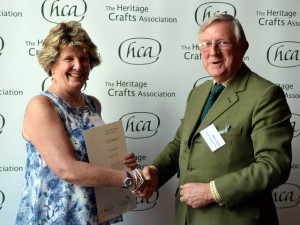Mary English – Ceramicist
6th July 2015 | ALUMNI | AWARD WINNERS
 Winner of the 2015 HCA/Marsh Trainer Award
Winner of the 2015 HCA/Marsh Trainer Award
Mary has been working in ceramics for 25 years, in particular the ancient process of pit-firing. She is especially interested in the links between history, art, chemistry and anthropology. She exhibits and sells her work, some of which appears in national and international collections.
Her enthusiasm is passed through to her students through demonstrations, lectures and workshops in various different environments, from schools to festivals. Trainees have progressed into higher education, have expanded their own art practices and several now instruct others in the method of pit-firing.
Photo: Mary English being presented with her certificate by Nick Carter, Marsh Christian Trust
